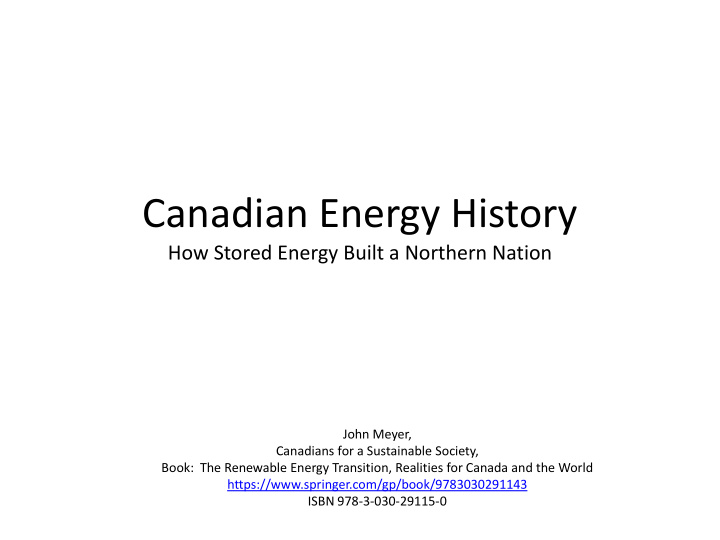



Canadian Energy History How Stored Energy Built a Northern Nation John Meyer, Canadians for a Sustainable Society, Book: The Renewable Energy Transition, Realities for Canada and the World https://www.springer.com/gp/book/9783030291143 ISBN 978-3-030-29115-0
Time to get Serious and use real social and biophysical economic metrics
Pre-Contact Population Density Population density (net Inuit - 1 person/700 sq km energy proxy) utterly Greenland Viking - dependent on pop < 5,000 climate and resources at Southern Ontario – hand. 1 person/10 sq km Most of Canada Cohakian Mounds - 2 people/sq km “empty” for a reason. Southern California 1 person / sq km Central America - 100 people per sq km
Process of Development Steel axes and saws >>> Firewood >>> Heating >>> Settle best farmland Coal >>> Rail Transport >>> Industry, Prairie & Northern Communities Oil >>> Ground and Air transport >>> anywhere anytime capability Electricity >>> Sophisticated industrial capacity, residential and farm comfort anywhere in Canada
Energy Consumption History
Solar Capacity vs Energy Demand for Northern Regions Monthly Average High Solar Capacity Factor Temperature 25 40 30 20 Capacity Factor % 20 Average High in Celcius 15 10 Igloolik 10 Igloolik 0 Guadalajara Jan Feb Mar Apr May Jun Jul Aug Sep Oct Nov Dec Guadalajara -10 5 -20 0 -30 January Feb Mar Apr May Jun Jul Aug Sep Oct Nov Dec -40
Degree Days by Latitude Heating Degree Days 12000 10000 8000 6000 4000 Heating Degree Days 2000 0
Residential Daily Energy Budget 40.0 35.0 30.0 kilo Watt hours per day 25.0 20.0 Energy / Capita 15.0 10.0 5.0 0.0 India Brazil Mexico China Spain Japan UK Russia Germany USA Canada Norway
Need for Unified Energy Measure to represent daily per capita energy budget Total Daily Energy Consumption kWhrs / Capita / Day 400.0 350.0 kilo Watt hours per day 300.0 250.0 200.0 Energy / Capita 150.0 100.0 50.0 0.0 India Mexico Brazil China Spain UK Japan Russia Germany USA Norway Canada
The Small Problem of Seasonal Storage • Storage and Investment by Latitude Annual Storage Size of Array Budget Required Storage Required Required kWh Days Annual kWh kilo Watts Storage Array Total 14600 120 4800 63.4 $ 4,080,000 $ 126,736 $ 4,206,736 Igloolik 10950 90 2700 27.2 $ 2,295,000 $ 54,315 $ 2,349,315 Calgary 7300 60 1200 17.3 $ 1,020,000 $ 34,564 $ 1,054,564 Victoria 10950 90 2700 28.5 $ 2,295,000 $ 57,031 $ 2,352,031 St. John's 4380 4 48 3.2 $ 40,800 $ 6,337 $ 47,137 Wilmington 1825 0.5 2.5 0.7 $ 2,125 $ 1,302 $ 3,427 Guadalajara
EROI - Energy Return on Energy Invested E-ROY • Available net energy is the core national determinant of real wealth creation. • EROI of oil in the glory days of Texas and Saudi gushers maybe reached 100:1 • EROI of current world oil industry ~17:1 • Oil Sands ~ 4:1, not including remediation • Solar ~ 8:1** • Wind ~ 15:1 • EROI of at least 8:1 needed for semi-sophisticated society. • Charles Hall: “Energy and the Wealth of Nations”
Are we making money yet? 40000 Royalty vs Legacy Cost Profit or Loss per Albertan 30000 20000 Canadian $ per Albertan 10000 0 Conventional Oil Natural Gas Oil Sands Royalty per Capita -10000 Legacy Cost/capita Royalty minus Legacy -20000 -30000 -40000 -50000 -60000
Financial problems and political problems in dealing with one industry economies. Resilient societies have a broad economic base.
EROI Mountain
COP to the Rescue? Can coefficient of performance of electrical heating systems offset the decline in EROI? Drake Landing - 30:1
Drake Landing Geothermal Storage Art Hunter, Sweden
mTonnes of CO2 equivalent -150 -100 100 150 200 250 300 -50 50 0 1990 1991 Planting Trees as Salvation? 1992 1993 1994 1995 1996 1997 1998 1999 2000 Net GHG Forest Emissions 2001 2002 2003 2004 2005 2006 2007 2008 2009 2010 2011 2012 2013 2014 2015 2016 Net GHG Forest Emissions
The Different Energy Levels of Fossil Fuel vs Electrical Societies
The Grid as a Living Organism
Energy Intensity of Income by Latitude 120 100 Energy Used per Dollar of Income 80 $18,000 60 $12,000 $6,000 40 $3,000 20 $1,500 $1,500 0 $1,100 $6,000 $18,000 Energy Equality - Richard W. Unger, as well as energy consumption history slide “Energy Consumption in Canada in the 19 th and 20 th Centuries” Even if technically excellent, the transition to renewables won’t work if it isn’t well explained and if it pushes the already poor and stressed into a more desperate situation. Witness Syria, France “Yellow Vests” and Ontario. Environmental balance also has to produce social balance.
Policy Priorities The fastest, best ways to transition off fossil fuels • EVs – easiest, fastest, biggest payoff, cheapest • Get young hands and minds working on real systems with data collection and open source control programs • (Art Hunter’s system with enhancements and external readout screens in 10ft or 20ft containers outside every high school and college in the country. PV, wind, solar hot air/water, insulation, external blinds, geothermal, heat pump, etc.) • Energy Audit for every building using one metric (kWh). People have no idea how much energy they use outside of $$$. • Start drilling holes for geothermal storage all across Canada (drill borehole infrastructure for district heating, large complexes, maybe not work in the far north) • Landlord/tenant coordination to encourage upgrading • Stop making buildings which can’t be retrofitted • Workforce re-training program across country – Alberta oil workers, German coal workers
Thank You!
Recommend
More recommend